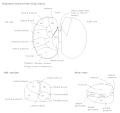This article has multiple issues. Please help improve it or discuss these issues on the talk page . (Learn how and when to remove these messages)
|
| Medial geniculate nucleus | |
|---|---|
 Thalamic nuclei: MNG = Midline nuclear group AN = Anterior nuclear group MD = Medial dorsal nucleus VNG = Ventral nuclear group VA = Ventral anterior nucleus VL = Ventral lateral nucleus VPL = Ventral posterolateral nucleus VPM = Ventral posteromedial nucleus LNG = Lateral nuclear group PUL = Pulvinar MTh = Metathalamus LG = Lateral geniculate nucleus MG = Medial geniculate nucleus | |
 Auditory pathway (Medial geniculate body labeled at upper right, second from top) | |
| Details | |
| Part of | Thalamus |
| System | Auditory system |
| Artery | Striate |
| Identifiers | |
| Latin | corpus geniculatum mediale |
| NeuroNames | 355 |
| NeuroLex ID | birnlex_1670 |
| TA98 | A14.1.08.303 A14.1.08.808 |
| TA2 | 5667, 5702 |
| FMA | 62211 |
| Anatomical terms of neuroanatomy | |
The medial geniculate nucleus (MGN) or medial geniculate body (MGB) is part of the auditory thalamus and represents the thalamic relay between the inferior colliculus (IC) and the auditory cortex (AC). [1] It is made up of a number of sub-nuclei that are distinguished by their neuronal morphology and density, by their afferent and efferent connections, and by the coding properties of their neurons. [2] It is thought that the MGN influences the direction and maintenance of attention.






